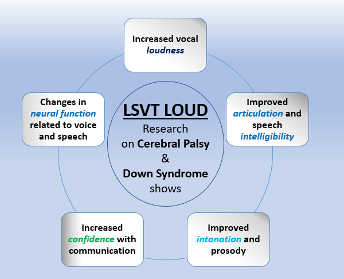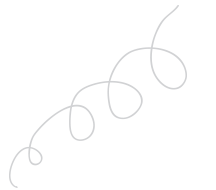
When loudness “unlocks” clear speech
Many children that we see at High Hopes have motor speech disorders as a result of brain damage before or during birth (Cerebral Palsy), or as part of their syndrome (e.g. Down Syndrome). Children with motor speech disorders are often difficult to understand, and this aspect, also known as intelligibility, is seen as what mainly contributes to negatively impacting their social functioning. In some cases, they may only be able to produce short phrases, single words or no intelligible speech at all. Most of these children also need help to learn to speak aloud.
When loudness improves as a result of treatment, it has been proven to also have positive effect on all the other speech and communication skills needed to boost intelligibility, thus significantly improving children’s quality of life. The most researched treatment approach that targets speaking aloud is called LSVT LOUD.
What is LSVT LOUD?
LSVT LOUD is a standardized treatment protocol that is customized to the unique communication goals of each person across a range of disease severity and communication impairments.
LSVT LOUD treatment consists of:
- 16 sessions: 4 consecutive days a week for 4weeks
- Individual 1-hour sessions
- Daily homework practice
- Daily carryover exercises
A little history on LSVT LOUD
Originally developed for the treatment of speech and voice disorders in patients with Parkinson Disease
LSVT LOUD is the first speech treatment with level 1 evidence and established efficacy for treating voice and speech disorders in people with Parkinson disease with application to other neurological disorders. The LSVT Programs have been developed and scientifically researched on patients with Parkinson Disease over the past 25 years with funding from the National Institutes of Health, in the United States. Outcome data from such extensive research have been published in a series of refereed articles in speech, otolaryngology and neurology journals. Although LSVT LOUD was originally developed for the treatment of Parkinson Disease, preliminary studies show that its application to select paediatric populations is promising.
The outcomes of LSVT LOUD
As illustrated in the figure below, research on LSVT LOUD has documented improved impact on multiple levels of functioning in people following treatment, including:
- Increased vocal loudness
- Improved articulation and speech intelligibility
- Improved intonation
- Improvements in confidence with communication overall, including facial expression
- Changes in neural functioning related to voice and speech

Figure 1- LSVT LOUD Treatment benefits for children with Cerebral Palsy or Down Syndrome
Treatment Fidelity
LSVT LOUD is an evidence based standardized approach, and as such, it is subject to close monitoring by LSVT Global to ensure that it is implemented as planned, delivered consistently and reliably (in a comparable manner between clinicians). The name LSVT may not be used to describe any alternative delivery options (such as a dosage less than one-hour sessions, four consecutive days per week for four weeks) to the standard treatment protocol, except as taught in the training course. This policy is consistent with the standard of the treatment evidence supporting LSVT BIG and LSVT LOUD as a part of evidence-based practice.”
It is unethical to imply to patients that they would be receiving a standard LSVT protocol if any element of the protocol is changed. Use of the name LSVT associated with any treatment other than full protocol LSVT would be unfair to the patients and would misrepresent the scientific and clinical data that support this treatment approach.
It is essential that LSVT LOUD treatment is only delivered by speech-language pathologists/ therapists who are certified in this method. Over 24,000 speech therapists from 70 countries have been certified in LSVT LOUD, but less than 50 are in the United Arab Emirates.
LSVT Loud is available to children at High Hopes
At High Hopes, our speech and language therapy department includes specialists trained in LSVT LOUD with an interest in paediatric motor speech disorders.
Sources:
- Fox, C.M., Boliek, C.A. (2012). Intensive Voice Treatment (LSVT LOUD) for Children With Spastic Cerebral Palsy and Dysarthria. Journal of Speech, Language and Hearing Research, 55-3, 930-945 https://pubs.asha.org/doi/full/10.1044/1092-4388%282011/10-0235%29
- Bakhtiari, R., Cummine, J., et. Al. Changes in brain activity following intensive voice treatment in children with cerebral palsy. Human Brain Mapping, 38-9, 4413-4419 https://onlinelibrary.wiley.com/doi/full/10.1002/hbm.23669
- Boliek, C.A. , Hardy, T.L.D., The Effects of Intensive Voice Treatment (LSVT LOUD®) on Speech Motor Control in Children with Down Syndrome, poster presentation at the University of Alberta
https://blog.lsvtglobal.com/wp-content/uploads/2019/12/Keystone-Poster-Presentation_January-2016-LSVT-LOUD-and-Down-syndrome.pdf - Ramig, L. O., Halpern, A., Spielman, J., Fox, C., & Freeman, K. (2018). Speech treatment in Parkinson’s Disease: Randomized Controlled Trial (RCT). Movement Disorders, 1-15. https://doi.org/10.1002/mds.27460
- Ramig, L., et al. (2001). Intensive voice treatment (LSVT) for individuals with Parkinson disease: A two-year followup. J. Neurology, Neurosurgery, and Psychiatry. 71, 493-498.
- Mahler LA, Ramig LO, Fox C. (2015). Evidence-based treatment of voice and speech disorders in Parkinson disease. Curr Opin Otolaryngol Head Neck Surg. 2015 Jun;23(3):209-15. PMID: 2594396615.
- LSVT Global, Inc. Phone: 1-888-438-5788 Email: info@LSVTGlobal.com Website: www.LSVTGlobal.com





